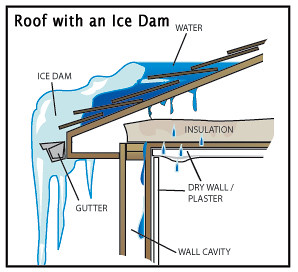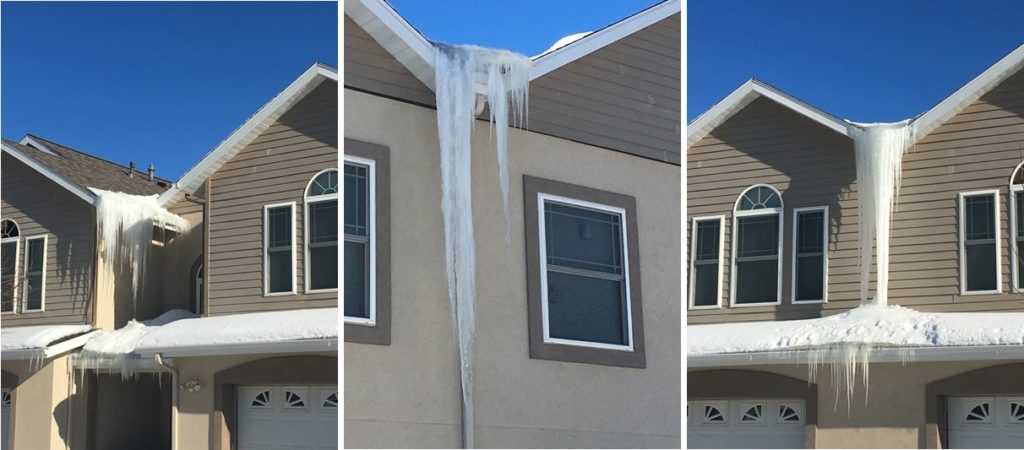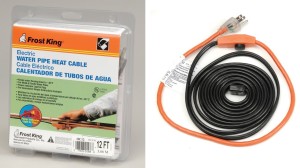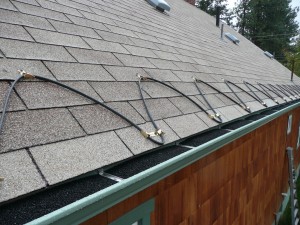The roofing system consists of four vital components: The Roof cover material Attic ventilation Attic Insulation Rain gutters & Proper roof drainage All of these...READ MORE »
Poor attic ventilation causes ice dams
Ice dams are caused by several different factors, poor attic ventilation being the largest factor. If excessive heat passes through the roof deck and melts the snow, an ice dam can form. When this cycle happens repeatedly, a wall of ice will form that will hold water on the roof.
This slushy water often will then leak into the home.
Most Trusted Roofer in Denver




Ice dams are a wintertime nightmare
Large snowfalls or blizzards lead to ice dams – which then can lead to big problems with your roof. Here is how they happen:
First comes the snow, which piles up on your roof. Rising heat from a poorly insulated attic heats up the roof, but not the overhanging eaves.
A sunny day only adds to the problem.
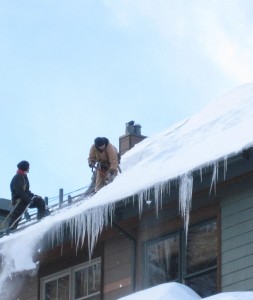 As the snow melts, the water runs down the roof, where it is stopped by the snow that hasn’t melted on the cold overhang. The result: an ice dam at the overhang that backs up the water, sending it under shingles, through nail holes, and into your house.
As the snow melts, the water runs down the roof, where it is stopped by the snow that hasn’t melted on the cold overhang. The result: an ice dam at the overhang that backs up the water, sending it under shingles, through nail holes, and into your house.
Gutters can suffer the same fate.
Ice builds up on gutters, forcing water up and under roofing material and shingles. It’s not uncommon to see gutters collapse as the weight of the ice breaks them loose from the fascia board.
Ice dams cause standing water on the roof which makes its way under the roof to cause a leak. Ice dams can also damage the siding and trim boards.
In extreme cases the ice dam will rip a gutter clean off the home. If you develop an ice dam call us immediately and we can clear the ice completely from your home and take preventative measures to help resolve the problem.
Once a specialist comes out to physically remove the ice off your roof, there is a high probability the removal will damage your roof.
Preventing Ice Dams
A straightforward method to try and prevent ice dams is to simply shovel your roof. Removing the snow off the roof before it melts and freezes will prevent ice dams. Snow roof rakes can also be purchased and can be used from the ground to remove snow from the roof.
Another method involves installing a “cold roof.” A cold roof is essentially a ceiling installed in your attic. This creates a barrier of air between the roof and attic and will act as an additional layer of insulation and keeps the snow from melting and re-freezing on your roof. Cold roofs are very common in mountain areas.
The last resort to ice dam prevention is heat cable, or heat trace. Heat cable is a line of cable installed near the roof edge where ice dams form. The heat cable gets warm and allows the water to escape through drip lines. A combination of good attic ventilation, 20 inches of attic insulation and installed heat cable will prevent ice dams even in the most extreme cold weather environments.
Read more on Heat Cables below.
At the end of the day, there is only one true effective way to prevent ice dams:
Attic insulation should be added to cut the amount of heat that escapes through the roof.
Bathroom vents, electrical outlets, plumbing vents, furnace stacks and access doors are culprits in heat escape, and should be insulated in the attic as well. Ideally, the temperature in an attic space should be close to the same temperature as the outside air.
A properly insulated attic goes a long way toward assuring this.
If it’s well planned and installed, roof ventilation will do its job to allow air to circulate through the attic. During the winter months, it allows heat to escape the attic space, preventing the roof deck from warming. The crippling freeze-thaw process isn’t likely to occur.
Underlayments, including the Owens Corning WeatherLock ice and water guard that Excel Roofing recommends, adhere directly to the roof deck, creating a watertight barrier between the roof deck and the shingles.
An ice and water shield is installed to protect the areas where the overhangs exist and at roof penetrations. It’s important to note that the use of ice and water shield will not fully protect the roof deck and prevent interior leaks from ice dams. Proper attic insulation and ventilation are needed to prevent an ice dam from occurring.
One way to mitigate this problem is to have heat cable installed. Although heat cable doesn’t fully prevent ice dams from forming, it definitely helps the situation. Another option is to get on your roof and shovel off the snow.
Your Next Best Attic Ventilation Options:
Related Topics
Attic Ventilation
Attic ventilation is critical to getting the most life out of the roof covering. Attic ventilation also play a large role in keeping the home...READ MORE »
Preventing Ice Dams with a Heat Cable
Heat trace, or more commonly known as heat cable, is a form of ice dam and gutter freezing prevention.
The cable is installed where ice dams build up, typically at the eaves and in the gutters. The cable heats up like a heating pad to prevent the ice dam from forming.
Heat cable comes in two basic varieties: heavy duty and light duty.
Heavy Duty Heat Cable vs Light Duty Heat Cable
Ways to install a heat cable
Roof heat cable is installed in a zig-zag pattern along the edge of the roof, generally at the eave or bottom of the roof where ice dams form. For extra protection the heat cable can be run up valleys or in other problem areas into the gutter and downspout.
If not installed properly the heat cable will not prevent ice dams. Depending on the weather environment and the type of cable installed, the heat cable is either run all winter long or used on an as-needed basis.
How we can help
Excel Roofing will install heat cable. The cost is $15 per foot of the heavy duty cable and $7.50 a foot of the light duty cable. When installing the zig-zag pattern, two feet of cable is required for each foot of roof line. If a gutter is present, it must be heated as well. This means it takes three feet of cable to heat each foot of combined roof and gutter.
The downside of heat cable is the relatively higher cost involved and an additional expense to your power bill.
Heat cable is more of a last resort solution. The preferable method for prevention is proper insulation and ventilation in your attic.
Ice dams are a wintertime threat to your home and heat cable can be an effective measure to prevent them.
Roof Insurance Experts
Your local roof insurance expert is here to help. Allow us to offer you a free, honest roof inspection. We’ll let you know if you should file a claim or not.

